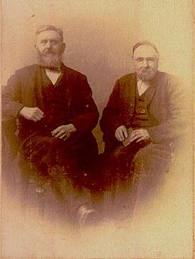Annotation:John McNeil's Reel: Difference between revisions
No edit summary |
No edit summary |
||
| (2 intermediate revisions by 2 users not shown) | |||
| Line 1: | Line 1: | ||
---------- | |||
---- | {{TuneAnnotation | ||
|f_tune_annotation_title= https://tunearch.org/wiki/Annotation:John_McNeil's_Reel > | |||
'''JOHN McNEIL('S REEL)'''. AKA and see "[[Betty's Fancy (2)]]," "[[Big John McNeil]]," "[[Big John McNeill]]," "[[Big John McNeal]]," "[[John McNeilis]]." Scottish (Originally), Irish, Canadian; Reel or Strathspey. Ireland, County Donegal. A Major. Standard tuning (fiddle). AB. The title undoubtedly honors a champion highland dancer of the Victorian era, John McNeil. Donald R Mackenzie, Professor of Dancing, Stirling, Scotland wrote in 1910 that some of the best "Highland step-dancers" of his time were John MacNeil, and William MacLennan ( the world famous piper and dancer): "The characteristic dancing styles of these two men were truly Highland, artistic and without any affectation." (See also note for "[[John McNeill's Highland Fling]]" for more on McNeil). | |f_annotation='''JOHN McNEIL('S REEL)'''. AKA and see "[[Betty's Fancy (2)]]," "[[Big John McNeil]]," "[[Big John McNeill]]," "[[Big John McNeal]]," "[[John McNeilis]]." Scottish (Originally), Irish, Canadian; Reel or Strathspey. Ireland, County Donegal. A Major. Standard tuning (fiddle). AB. The title undoubtedly honors a champion highland dancer of the Victorian era, John McNeil. Donald R Mackenzie, Professor of Dancing, Stirling, Scotland wrote in 1910 that some of the best "Highland step-dancers" of his time were John MacNeil, and William MacLennan ( the world famous piper and dancer): "The characteristic dancing styles of these two men were truly Highland, artistic and without any affectation." (See also note for "[[John McNeill's Highland Fling]]" for more on McNeil). | ||
[[File:lyallmilne.jpg|200px|thumb|left|Peter Milne is on right]] | [[File:lyallmilne.jpg|200px|thumb|left|Peter Milne is on right]] | ||
<br> | <br> | ||
| Line 10: | Line 10: | ||
<br> | <br> | ||
The tune has wide currency in several genres, including American contest fiddling. American fiddlers sometimes mistakenly believe it is a Canadian tune, as it has long been popular with northern musicians. | The tune has wide currency in several genres, including American contest fiddling. American fiddlers sometimes mistakenly believe it is a Canadian tune, as it has long been popular with northern musicians. | ||
|f_source_for_notated_version= Danny O'Donnell (County Donegal), who was familiar with Scottish music in the Donegal tradition but who also worked in Scotland [Feldman & O'Doherty]. | |||
|f_printed_sources=Hunter ('''Fiddle Music of Scotland'''), 1988; No. 237. Feldman & O'Doherty ('''The Northern Fiddler'''), p. 187. Martin ('''Ceol na Fidhle, vol. 3'''), 1988; p. 46. Milne ('''Middleton’s Selection of Strathspeys, Reels &c. for the Violin'''), 1870; p. 23. Moffat ('''Dance Music of the North'''), 1908; No. 31, p. 14. | |||
|f_recorded_sources=Olympic 6151, Angus Cameron - "Scottish Traditional Fiddle Music" (1978). Battlefield Band - "Battlefield Band" (appears as part of set which includes "[[Inverness Gathering (The)]]" and "[[Marquis of Huntley's Strathspey]]"). | |||
|f_see_also_listing= | |||
}} | |||
Latest revision as of 03:15, 19 July 2024
X:1 T:John McNeil’s Reel C:Peter Milne M:C| L:1/8 R:Reel B:Milne – Middleton’s Selection of Strathspeys, Reels &c. for the Violin (1870, p. 23) Z:AK/Fiddler’s Companion K:A C|A,2 CE (FE)CE|AECE FECE|A,2 CE (FE)CE|FAGF EDCB,| A,2 CE (FE)CE|AECE FEDC|B,DCE DFE=G|FA^GB cAA|| f|eAfA eAca|eAfA e2 (f/ga)|eAfA eAce|dfca B2 (d/e/f)| eAfA eAca|eAfA e2 (e/f/g/)|agag fedc|BAGF EDB,|| |"last time"agaf ecde|fagb a2 a||z/a/|[A6a6]||
JOHN McNEIL('S REEL). AKA and see "Betty's Fancy (2)," "Big John McNeil," "Big John McNeill," "Big John McNeal," "John McNeilis." Scottish (Originally), Irish, Canadian; Reel or Strathspey. Ireland, County Donegal. A Major. Standard tuning (fiddle). AB. The title undoubtedly honors a champion highland dancer of the Victorian era, John McNeil. Donald R Mackenzie, Professor of Dancing, Stirling, Scotland wrote in 1910 that some of the best "Highland step-dancers" of his time were John MacNeil, and William MacLennan ( the world famous piper and dancer): "The characteristic dancing styles of these two men were truly Highland, artistic and without any affectation." (See also note for "John McNeill's Highland Fling" for more on McNeil).

"John McNeil (Champion Highland Dancer)" was composed as a strathspey by self-taught albeit masterful fiddler Peter Milne (1824-1908), a native of Aberdeenshire and one of J. Scott Skinner's teachers. Milne earned a living teaching and playing in theaters until his opium addiction (he had originally taken laudanum in London for rheumatism) reduced him to busking on ferry-boats plowing the Forth of Firth. The completion of the Forth Bridge (c. 1890) deprived him of even this livelihood, and he died destitute in an insane asylum. As "Big John McNeil" the melody is quite popular with Canadian and New England fiddlers. John McNeil was a champion Highland dancer in Edinburgh at the turn of the century. The tune is well-known in County Donegal where the first part is played in the upper octave on the fiddle for "reversing" purposes, according to fiddler Caoimhin Mac Aoidh. Alternate local Donegal names for the melody include "Betty's Fancy" and "John McNeilis" (the latter is a Donegal adaptation of the name McNeil). See also the similar "Lord Ramsay's Reel (4)."
The tune has wide currency in several genres, including American contest fiddling. American fiddlers sometimes mistakenly believe it is a Canadian tune, as it has long been popular with northern musicians.

